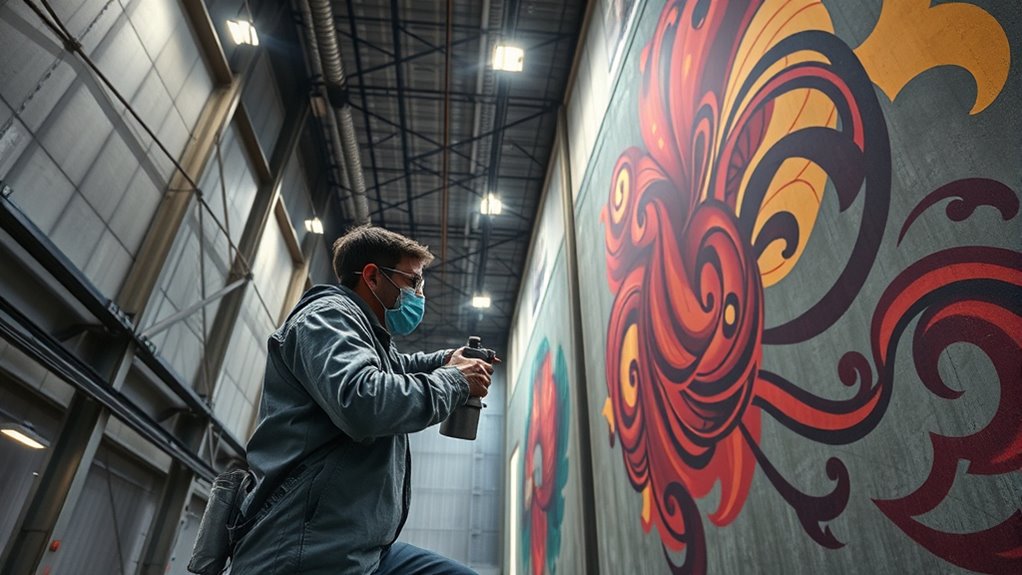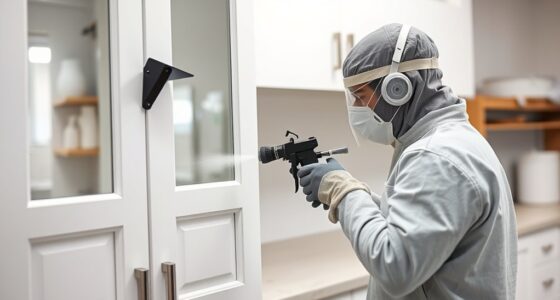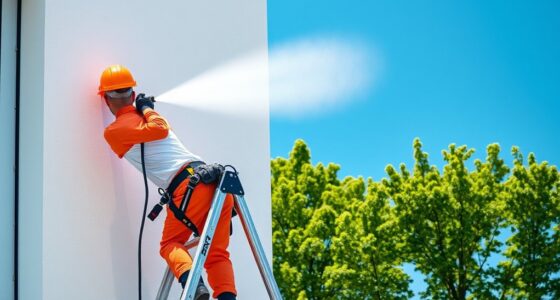To spray ceilings and high walls safely from the floor, use extension poles attached securely to your spray gun to reach high areas without leaning or overreaching. Maintain a steady distance of 12-18 inches from the surface, moving smoothly and overlapping slightly with each pass. Use scaffolding or sturdy ladders with a spotter if needed, but prioritize stability and safety. Keep control and avoid overspray—continue ahead to discover more tips for flawless, safe results.
Key Takeaways
- Use extension poles attached securely to spray guns for safe, comfortable reach of ceilings and high walls.
- Maintain a consistent 12-18 inch distance from surfaces to ensure even coverage and minimize overspray.
- Test spray patterns on scrap surfaces before starting to ensure proper settings and avoid drips or splatters.
- Work with stable scaffolding or ladders, avoiding overreaching or leaning to prevent falls or instability.
- Wear protective gear like masks, goggles, and gloves to safeguard against fumes, overspray, and accidental drips.

Ceilings and high walls can dramatically influence the feel and functionality of a space. When you’re tackling painting projects in rooms with tall ceilings or expansive walls, safety and technique become even more critical. Reaching these areas from the floor presents unique challenges, but with the right approach, you can spray safely and effectively without risking injury or uneven coverage. The key is to plan thoroughly before you start. First, ensure you have the proper equipment, like a high-quality spray gun designed for your specific paint type, along with an extension pole or scaffold if necessary. Using a spray gun allows you to cover large areas quickly and uniformly, but it also means controlling the spray pattern to prevent overspray and drips, especially on high surfaces.
When working from the floor, you need to maintain stability and control. If you’re not using a ladder or scaffolding, an extension pole is your best tool, allowing you to reach high walls and ceilings comfortably. Always check that your extension pole is securely attached to your spray gun. This setup minimizes the need for ladders, which can be unstable and dangerous at height. If you do require a ladder, opt for a sturdy, well-placed one and work with a spotter if possible. Never overreach or lean too far while on a ladder; safety should always come first. Make sure to wear protective gear—such as goggles, a mask, and gloves—to shield yourself from overspray, fumes, and paint drips.
Before you begin spraying, test your equipment on a scrap surface or cardboard to gauge the spray pattern and paint flow. This step helps prevent unexpected splatters or uneven coverage on your walls and ceilings. When spraying, keep the gun at a consistent distance—usually about 12 to 18 inches from the surface—and move smoothly and steadily. Overlapping each pass slightly ensures even coverage, while quick, controlled motions help prevent drips and runs. Pay special attention to edges and corners, as these areas tend to require more precision.
Frequently Asked Questions
What Safety Gear Is Essential for Spraying Ceilings?
You should wear a respirator or mask to protect your lungs from fumes and overspray. Safety goggles are essential to shield your eyes from splatters, and gloves prevent skin contact with paint or chemicals. A hat or cap can keep debris out of your hair, while a long-sleeved shirt and pants help guard your skin. Don’t forget to use ear protection if you’re working with loud equipment.
How Do I Prevent Drips on High Walls?
To prevent drips on high walls, keep your spray gun at a consistent distance and move steadily to avoid buildup. Use a steady hand, and don’t overload the nozzle with paint. Taping off edges and using painter’s tape helps protect areas you don’t want to spray. Regularly check your spray pattern and adjust as needed, ensuring even coverage without excess paint that causes drips.
Can I Use the Same Equipment for Ceilings and Walls?
Imagine holding your spray gun like a painter’s brush, ready to transform your space. Yes, you can use the same equipment for ceilings and walls, but guarantee the nozzle and pressure settings suit each surface. Switch out filters if needed, and adjust your distance to prevent drips. With a little fine-tuning, your tools will work seamlessly, giving you smooth, professional results whether you’re reaching high or working close to the ground.
How Long Should I Wait Between Coats?
You should wait about 2 to 4 hours between coats, but it depends on the type of paint and environmental conditions. Check the manufacturer’s instructions for specific drying times, as factors like humidity and temperature can affect curing. To guarantee a smooth finish, wait until the first coat is thoroughly dry and no longer tacky before applying the next. Rushing this step can lead to uneven results or peeling.
What Are the Best Cleaning Practices After Spraying?
Did you know that proper cleaning can extend the life of your spray equipment by up to 50%? After spraying, you should immediately rinse your tools and equipment with water or the recommended solvent. Disassemble parts if possible, scrub off residue, and dry thoroughly. This prevents clogs and guarantees your tools stay in top condition. Regular cleaning also minimizes airborne particles, keeping your workspace safer and cleaner.
Conclusion
Now that you know how to spray safely from the floor, you’re like a skilled artist painting a masterpiece from beneath a vast sky. With the right techniques, heights won’t feel like barriers—they become just another canvas to conquer. Remember, safety is your paintbrush, guiding every stroke. So gear up, stay cautious, and transform challenging ceilings and high walls into your personal gallery of flawless, safe work.










